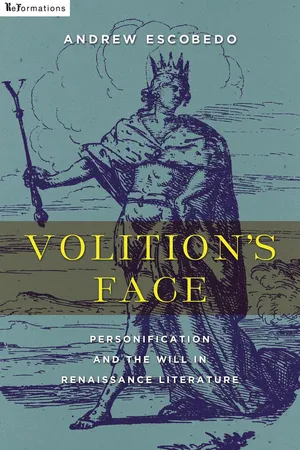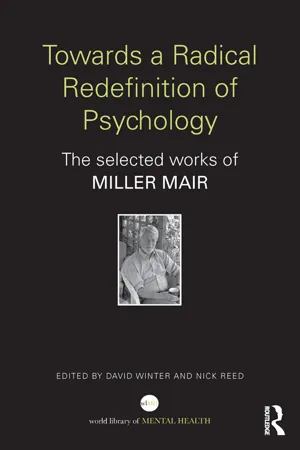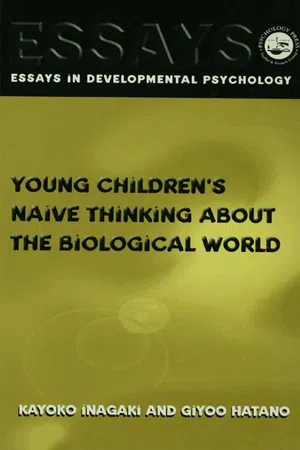Languages & Linguistics
Personification
Personification is a literary device that attributes human qualities, emotions, and actions to non-human entities such as animals, objects, or natural phenomena. It is often used to create a more vivid and engaging description of the subject, and to convey a deeper meaning or message to the reader. Personification is commonly used in poetry, fiction, and advertising.
Written by Perlego with AI-assistance
Related key terms
Related key terms
1 of 4
Related key terms
1 of 3
5 Key excerpts on "Personification"
- eBook - ePub
ReFormations: Medieval and Early Modern
Personification and the Will in Renaissance Literature
- Andrew Escobedo(Author)
- 2017(Publication Date)
- University of Notre Dame Press(Publisher)
Personification offers a concentrated, even exaggerated image of transactional selfhood. A literary character can sometimes own its choices to the degree that these choices appear to come from the inside and not only the outside; yet a Personification’s inside already seems as if it came from the outside. A Personification has an agency, but one that does not quite appear fully to belong to it. 28 Personification’s extreme transactionalism, its internal commitment to external forces, constitutes the figure’s most fundamental energy. It showcases Personification’s close relation to the dynamic agency of the daemon, which in Greek and Roman literature often magically possessed human beings, foisting upon them a driving sense of purpose, either good or bad. Having an inside so clearly impelled by the outside, manifesting the interior passions of the mind on the external landscape, Personifications enjoy a peculiar independence from the constraining effects of the narrative in which they appear. Famously, Personifications refuse to function according to scale or probability: they do not modulate their behavior in response to surrounding narrative circumstance, acting out their being in an untrammeled manner. This is not to deny that narrative circumstances can influence the reader’s understanding of a Personification’s significance, or that a writer using prosopopoeia may be “concerned with context and shades of meaning,” as David Aers has suggested. 29 Indeed, the daemonic basis of literary Personification complicates the figure’s general momentum from stasis to animation. Personification crosses a figurative threshold whereby an inanimate thing becomes, as it were, a living agent, but in a daemonic dispensation nothing is purely inanimate. Animae of all sorts literally circulate through the natural landscape and the human psyche - eBook - ePub
Practical Criticism
A Study of Literary Judgment
- I. A. Richards(Author)
- 2017(Publication Date)
- Routledge(Publisher)
“Animism,” as this writer calls it, the projection of human activity into inanimate objects of thought, has been expressly pointed to by innumerable critics as one of the most frequent resources of poetry. Coleridge, for example, declared that “images” (by which he meant figurative language) “become a proof of original genius. . . when a human and intellectual life is transferred to them from the poet’s own spirit.” And he instanced it as “that particular excellence... in which Shakespeare even in his earliest, as in his latest, works surpasses all other poets. It is by this, that he still gives a dignity and a passion to the objects which he presents. Unaided by any previous excitement, they burst upon us at once in life and power.” (Biographia Literaria, Ch. XV). There are indeed very good reasons why poetry should personify. The structure of language and the pronouns, verbs and adjectives that come most naturally to us, constantly invite us to personify. And, to go deeper, our attitudes, feelings, and ways of thought about inanimate things are moulded upon and grow out of our ways of thinking and feeling about one another. Our minds have developed with other human beings always in the foreground of our consciousness; we are shaped, mentally, by and through our dealings with other people. It is so in the history of the race and in the individual biography. 4 No wonder then if what we have to say about inanimate objects constantly presents itself in a form only appropriate, if strict sense is our sole consideration, to persons and human relations. Often, of course, there is no necessity for Personification so far as sense is concerned, and we use it only to express feelings towards whatever we are speaking about (Function 2). But sometimes Personification allows us to say compendiously and clearly what would be extraordinarily difficult to say without it - eBook - ePub
- Patrick Spread(Author)
- 2012(Publication Date)
- Routledge(Publisher)
Personification draws inanimate things or abstract concepts into the support-bargaining process. It creates agents that can engage in support-bargaining. It excites our sense of insecurity, then gives reassurance. Support, rather than truth, is important, and support derives from people. Popular stories and theories must deal with people, not with abstractions. Newspapers give interest to changes in taxation by focusing on the effects of changes on specific individuals or families. A rise in income tax means that ‘John and Jean Foresyt are thinking again about their holiday plans for this year. On hearing the news of the change, John said….’ While not actually personified, taxation is given a human face. Personification substitutes human motivation for the causation of the natural world. It creates clear understandings of situations in realistic human terms, familiar to everyone, and understandings of outcomes. It shifts theory making from the inanimate and abstract to the personal, intimate and familiar.Personification is then part of the storytelling that, as suggested above, gave rise to deity theory. The forces of nature were hard to understand as inanimate objects or noises and forces without observable origin. Transformed into human form, or quasi-human form, they were immediately more comprehensible. It was easy to talk about them. Personification also opened up what seemed to be opportunities for support-bargaining. People wanted the protection that these deities or ‘beings’ might provide, but recognised that, as with their human associates, some return would be required. So they imputed to the deities certain demands of the kind that they themselves would make if they had the power to protect humans from harm. The deities were assumed to require worship, sacrifices and adherence of their supplicants to certain rituals and forms of behaviour. Personification meant that people could have relationships with the deities as with friends and neighbours, or in some cases as with feared father-figures. The ancient Greeks and Romans conceived a great variety of deities as persons overseeing the various activities in which humans engage, such as love, war, the pursuit of prosperity, travel and communications. The deities had lives in their own domain that reflected the diversity and adversity of human life on earth. If a human knew the tricks of currying favour with the gods, all would go well for him. Jehovah, for the Jews, was a demanding personality, an austere judge of human weakness, punishing those who failed to follow his laws. Christians determined that he begot a son, Jesus Christ, by a virgin mother, who preached an ethic very like mutual aid. But God required also that the son make a brutal self-sacrifice to buy redemption for humanity. The abiding understanding is that Jesus Christ and his mother Mary intercede for humanity in the support-bargaining necessary to gain protection from the father. Their support is important to the father, so their word in support of human supplications carries weight. The understanding and the ethic is deeply woven into the support-bargaining processes of many nations and peoples. People respond to stories that personify the forces of nature with a readiness and commitment that cannot be stimulated by direct and dispassionate appraisal of such forces. Personification engages insecurities and offers the prospect of protection through the same support-bargaining process that is used to gain the protection of human associates. Societies create deities that help with the communal task of keeping individuals in line with the demands of the group. - eBook - ePub
Towards a Radical Redefinition of Psychology
The selected works of Miller Mair
- Miller Mair, David Winter, Nick Reed, David Winter, Nick Reed(Authors)
- 2014(Publication Date)
- Routledge(Publisher)
So also allegory can be seen as an extended metaphor or combination of many interrelated metaphors in the form of a story or drama, and fable, parable, and myth can also be included. Personification is also regarded as a form of metaphoric functioning where inanimate objects or abstract concepts can be treated as if they possessed human features. In a similar way paradigms and models can be viewed as specially elaborated forms of metaphoric functioning. A further important point about metaphor is made by Owen Thomas (1969). He suggests that, strictly speaking, only man can “make statements” which are not true, and we often state ideas in terms which are logically contradictory. So in metaphor we are really making a “mistake” or a “series of mistakes” to some end. But Thomas reminds us that we need to have some systematic and accepted structuring of events, otherwise it would be impossible to make such “mistakes.” Language is such a complex, systematic structure whose rules, grammar and syntax give coherent form to our world, though no language encapsulates the ultimate forms of reality. Through metaphor or the kind of “mistake making” which metaphor involves, we break the “rules” in various ways and so stretch the boundaries of our understanding. Such “stretching” is done by both keeping the rules and breaking them. A “command of metaphor” would seem then to involve some skill in breaking the rules, but this can only be done by having and respecting conventions which can be broken. As in some modern poetry, jumbles of metaphors with little or no structure against which to highlight the invention of new meanings may result in strain and confusion (thus possibly, after all, forming an effective metaphor of much of our modern experience of living) and we may be in danger of losing both the “baby” of new meanings with the “bath water” of accepted forms - eBook - ePub
- Giyoo Hatano, Kayoko Inagaki(Authors)
- 2013(Publication Date)
- Psychology Press(Publisher)
In contrast to Piaget (1929), who regarded personifying or animistic responses as a sign of immaturity, we consider Personification to be a form of plausible reasoning that generates “educated guesses”; we see it as adaptive in nature, especially when a cognizer does not possess rich knowledge about the target entity or its close neighbors. Moreover, Personification can often be used as a sort of inference in the biological mode for understanding biological phenomena. Next, we present experimental evidence from our studies to support our idea of constrained Personification. In the third and fourth sections, we discuss the essential roles Personification plays in the construction of naive biology, specifically in the acquisition of the concept of living things and the expansion of biological knowledge, respectively. Young Children’s Constrained Personification Why do Young Children use Personification? As revealed in Chapter 2, young children have the factual knowledge needed to distinguish between humans, nonhuman animals, plants, and typical nonliving things. However, compared with adults, children’s experience is generally so limited that their specific knowledge about animals and plants is still scarce and not always hierarchically structured; they do not have enough knowledge to make correct or reliable predictions about specific objects’ attributes and behaviors. In contrast, even young children have fairly rich knowledge about humans, because they themselves are humans, and it is humans as conspecifics that they most often interact with in their life. In the R. Gelman et al. (1983) study described earlier, almost all the 3-year-olds correctly attributed to a person those properties that humans possess, such as body parts (e.g., ears, stomach), overt actions (e.g., walk, eat), or mental states and acts (e.g., feel sad, think)
Index pages curate the most relevant extracts from our library of academic textbooks. They’ve been created using an in-house natural language model (NLM), each adding context and meaning to key research topics.
Explore more topic indexes
Explore more topic indexes
1 of 6
Explore more topic indexes
1 of 4




